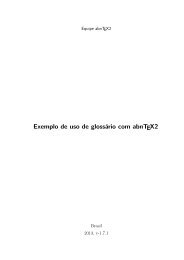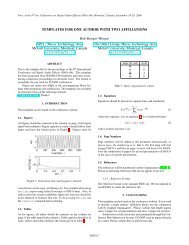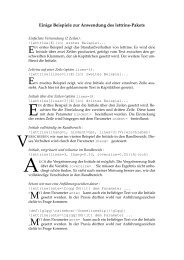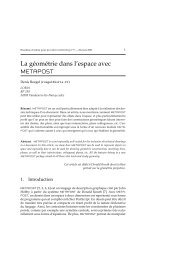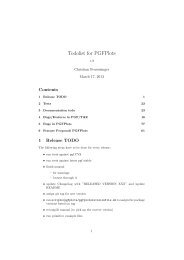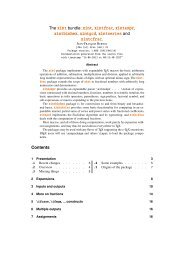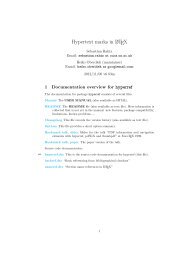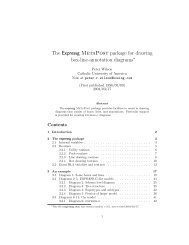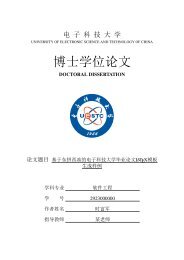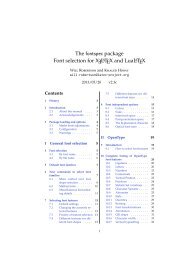thai.pdf.
thai.pdf.
thai.pdf.
You also want an ePaper? Increase the reach of your titles
YUMPU automatically turns print PDFs into web optimized ePapers that Google loves.
1 The Thai language<br />
The file <strong>thai</strong>.dtx 1 defines language-specific macros for Thai language.<br />
1.1 Input encoding<br />
\<strong>thai</strong>text<br />
Thai documents supported by this language definition can be encoded in either<br />
TIS-620 (ISO/IEC 8859-11) or UTF-8 with the aids of the inputenc package.<br />
The commands \<strong>thai</strong>text and \latintext can be used to switch to Thai or<br />
\latintext Latin fonts. These are declarations.<br />
\text<strong>thai</strong> The commands \text<strong>thai</strong> and \textlatin both take one text argument which<br />
\textlatin is then typeset using the requested language settings.<br />
\textpali<br />
\wbr<br />
The command \textpali takes one text argument which is then typeset using<br />
Thai font, with special shapes for certain characters, such as descender-less Yo<br />
Ying and Tho Than, as required by usual Pali-Sanskrit transliteration.<br />
1.2 Word breaks<br />
Thai is written continuously without word delimitors. The word boundary analysis<br />
is considered too complicated for rule-based approaches. Most available goodquality<br />
word analysis tools employ special matching algorithms against pre-defined<br />
dictionaries. Some even use statistics-based contextual analysis to resolve ambiguities.<br />
Therefore, no good hyphenation pattern is found to be comparable with<br />
those tools yet.<br />
What provided here for the word boundary problem is the \wbr command for<br />
separating words. It delimits words without taking physical space, so that the<br />
TEX typesetter still wraps lines at word boundary like when it typesets English<br />
text.<br />
Therefore, one can preprocess their Thai document using Thai word analysis<br />
tools which automatically insert the \wbr commands between words, such as:<br />
• cttex by Vuthichai Ampornaramveth<br />
• swath by Phaisarn Charoenpornsawat, now maintained by Thai Linux Working<br />
Group, which can be downloaded from:<br />
ftp://linux.<strong>thai</strong>.net/pub/<strong>thai</strong>linux/software/swath<br />
To compile swath, you need libdatrie as the dependency, which is provided<br />
under the lib<strong>thai</strong> project:<br />
ftp://linux.<strong>thai</strong>.net/pub/<strong>thai</strong>linux/software/lib<strong>thai</strong><br />
1 The file described in this section has version number v1.8 and was last revised on 2013/03/31.<br />
The original author was Surapant Meknavin, and it was composed into <strong>thai</strong>.dtx and maintained<br />
by Theppitak Karoonboonyanan (thep@linux.<strong>thai</strong>.net).<br />
1
<strong>thai</strong>indentfirst<br />
<strong>thai</strong>number<br />
1.3 Thai paragraph<br />
Generally speaking, Thai paragraph uses the same rule as in English. However,<br />
there are some differences, such as how to start the paragraph in a new chapter<br />
or section.<br />
As suggested by English writing guideline, the first paragraph in each section<br />
shall not be indented. However, for Thai language, indenting the first paragraph<br />
is more popular and widely suggested. The option <strong>thai</strong>indentfirst can be used to<br />
control this behavior.<br />
1.4 Thai numbering<br />
Some certain Thai documents use Thai digits instead of Arabic. And Thai alphabetic<br />
numbering is also commonly used for appendices. This file provides a number<br />
of numbering styles that can be applied to L ATEX \pagenumbering command:<br />
• \<strong>thai</strong>num for plain Thai digits<br />
• \<strong>thai</strong>bracenum for Thai digits in parentheses<br />
• \<strong>thai</strong>alph for Thai alphabetic numbering, using a reduced set (with three<br />
alphabets skipped: Kho Khuat, Kho Khon and Kho Rakhang)<br />
• \<strong>thai</strong>Alph for Thai alphabetic numbering, using the full set (with full alphabet<br />
set, plus two semi-vowels, Ru and Lu, in the order defined in Thai<br />
official dictionary)<br />
The above numbering styles can be automatically chosen using the <strong>thai</strong>number<br />
option. When this option is supplied to the babel package, Thai numberings will<br />
be applied to pages, sections, enumerations, dates, etc.<br />
1.5 Thai language definition<br />
The macro \LdfInit takes care of preventing file from being loaded more than<br />
once, checking the category code of the @ sign, etc.<br />
1 〈∗code〉<br />
2 \LdfInit\CurrentOption{captions\CurrentOption}<br />
When this file is read as an option, i.e. by the \usepackage{babel} command,<br />
<strong>thai</strong> will be an ‘unknown’ language, in which case we have to make it known. So,<br />
we check for the existence of \l@<strong>thai</strong> to see whether we have to do something<br />
here.<br />
3 \ifx\l@<strong>thai</strong>\@undefined<br />
4 \@nopatterns{<strong>thai</strong>}<br />
5 \adddialect\l@<strong>thai</strong>0\fi<br />
2
1.5.1 Thai character encoding<br />
In this language definition, we support TIS-620, the national standard 8-bit character<br />
encoding, and Unicode by means of inputenc package.<br />
The encoding has been described in terms of TIS-620 as LTH in the lthenc.def<br />
file. So, we require it.<br />
6 \InputIfFileExists{lthenc.def}%<br />
7 {\message{Loading the definitions for the Thai font encoding}}%<br />
8 {%<br />
9 \errhelp{I can’t find the lthenc.def file for the Thai fonts}%<br />
10 \errmessage{Since I do not know what the LTH encoding means^^J<br />
11 I can’t typeset Thai.^^J<br />
12 I stop here, while you get a suitable lthenc.def file}\@@end<br />
13 }<br />
The next step consists of defining commands to switch to the Thai language,<br />
for users to switch back and forth between languages.<br />
\<strong>thai</strong>text We define \<strong>thai</strong>text as a declarative switch to Thai font encoding.<br />
14 \DeclareRobustCommand{\<strong>thai</strong>text}{%<br />
15 \fontencoding{LTH}\selectfont%<br />
16 \def\encodingdefault{LTH}}<br />
\text<strong>thai</strong> This command takes one text argument which is then typeset using Thai font<br />
encoding.<br />
17 \DeclareRobustCommand{\text<strong>thai</strong>}[1]{{\<strong>thai</strong>text #1}}<br />
1.5.2 Pali-Sanskrit Transliteration<br />
Thai script can also be used for writing Pali and Sanskrit. Additional conventions<br />
are applied when doing so: (a) Yo Ying and Tho Than must be written without<br />
descender; (b) Phinthu is used for marking cluster; (c) Nikhahit is used as a Pali-<br />
Sanskrit consonant.<br />
(b) is inherently applicable as combining character. So is (c), with an exception<br />
for the case in which it is combined over upper vowel (namely, Sara I), where it<br />
must be shifted to higher position. Nikhahit shifting is implemented in the ligkern<br />
rules with the extra glyph provision in the fonts.<br />
What is left here is (a). Yo Ying and Tho Than must be converted to their<br />
descender-less variants. The \textpali macro is defined for this purpose. Note<br />
that \wbr commands which are normally inserted by automatic tools are ignored<br />
here, as most of such tools are not designed for Pali/Sanskrit. Besides,<br />
Pali/Sanskrit is already space delimited.<br />
\textpali This command converts all Yo Ying and Tho Than in its argument to their<br />
descender-less variations.<br />
18 \DeclareRobustCommand{\textpali}[1]{%<br />
19 \begingroup<br />
20 \def\<strong>thai</strong>YoYing{\textYoYingPali{}}%<br />
3
21 \def\<strong>thai</strong>ThoThan{\textThoThanPali{}}%<br />
22 \def\wbr{}%<br />
23 \scantokens\expandafter{#1}\relax<br />
24 \endgroup<br />
25 }<br />
1.5.3 Hyphenation<br />
We define \<strong>thai</strong>hyphenmins macro for hyphenation parameters. This is one of<br />
the five macros required by babel.<br />
\<strong>thai</strong>hyphenmins This macro is used to store the correct values of the hyphenation parameters<br />
\lefthyphenmin and \righthyphenmin. They are set to 11.<br />
26 \providehyphenmins{<strong>thai</strong>}{11}<br />
1.5.4 Captions translation<br />
We define \captions<strong>thai</strong> macro for translations of strings. This is one of the five<br />
macros required by babel.<br />
\captions<strong>thai</strong> The macro \captions<strong>thai</strong> defines all strings used in the four standard documentclasses<br />
provided with L ATEX.<br />
27 \addto\captions<strong>thai</strong>{%<br />
28 \def\prefacename{\<strong>thai</strong>KhoKhwai\<strong>thai</strong>SaraAm\<strong>thai</strong>NoNu\<strong>thai</strong>SaraAm}%<br />
29 \def\refname{\<strong>thai</strong>SaraE\<strong>thai</strong>OAng\<strong>thai</strong>KoKai\<strong>thai</strong>SoSua\<strong>thai</strong>SaraAa\<strong>thai</strong>RoRua%<br />
30 \<strong>thai</strong>OAng\<strong>thai</strong>MaiTho\<strong>thai</strong>SaraAa\<strong>thai</strong>NgoNgu%<br />
31 \<strong>thai</strong>OAng\<strong>thai</strong>SaraI\<strong>thai</strong>NgoNgu}%<br />
32 \def\abstractname{\<strong>thai</strong>BoBaimai\<strong>thai</strong>ThoThahan%<br />
33 \<strong>thai</strong>KhoKhwai\<strong>thai</strong>MaiHanakat\<strong>thai</strong>DoDek%<br />
34 \<strong>thai</strong>YoYak\<strong>thai</strong>MaiEk\<strong>thai</strong>OAng}%<br />
35 \def\bibname{\<strong>thai</strong>BoBaimai\<strong>thai</strong>RoRua\<strong>thai</strong>RoRua\<strong>thai</strong>NoNen\<strong>thai</strong>SaraAa%<br />
36 \<strong>thai</strong>NoNu\<strong>thai</strong>SaraU\<strong>thai</strong>KoKai\<strong>thai</strong>RoRua\<strong>thai</strong>MoMa}%<br />
37 \def\chaptername{\<strong>thai</strong>BoBaimai\<strong>thai</strong>ThoThahan%<br />
38 \<strong>thai</strong>ThoThahan\<strong>thai</strong>SaraIi\<strong>thai</strong>MaiEk}%<br />
39 \def\appendixname{\<strong>thai</strong>PhoSamphao\<strong>thai</strong>SaraAa\<strong>thai</strong>KhoKhwai%<br />
40 \<strong>thai</strong>PhoPhung\<strong>thai</strong>NoNu\<strong>thai</strong>WoWaen\<strong>thai</strong>KoKai}%<br />
41 \def\contentsname{\<strong>thai</strong>SoSua\<strong>thai</strong>SaraAa\<strong>thai</strong>RoRua%<br />
42 \<strong>thai</strong>BoBaimai\<strong>thai</strong>MaiHanakat\<strong>thai</strong>YoYing}%<br />
43 \def\listfigurename{\<strong>thai</strong>SoSua\<strong>thai</strong>SaraAa\<strong>thai</strong>RoRua%<br />
44 \<strong>thai</strong>BoBaimai\<strong>thai</strong>MaiHanakat\<strong>thai</strong>YoYing%<br />
45 \<strong>thai</strong>RoRua\<strong>thai</strong>SaraUu\<strong>thai</strong>PoPla}%<br />
46 \def\listtablename{\<strong>thai</strong>SoSua\<strong>thai</strong>SaraAa\<strong>thai</strong>RoRua%<br />
47 \<strong>thai</strong>BoBaimai\<strong>thai</strong>MaiHanakat\<strong>thai</strong>YoYing%<br />
48 \<strong>thai</strong>ToTao\<strong>thai</strong>SaraAa\<strong>thai</strong>RoRua\<strong>thai</strong>SaraAa\<strong>thai</strong>NgoNgu}%<br />
49 \def\indexname{\<strong>thai</strong>DoDek\<strong>thai</strong>RoRua\<strong>thai</strong>RoRua\<strong>thai</strong>ChoChang%<br />
50 \<strong>thai</strong>NoNu\<strong>thai</strong>SaraIi}%<br />
51 \def\figurename{\<strong>thai</strong>RoRua\<strong>thai</strong>SaraUu\<strong>thai</strong>PoPla%<br />
52 \<strong>thai</strong>ThoThahan\<strong>thai</strong>SaraIi\<strong>thai</strong>MaiEk}%<br />
53 \def\tablename{\<strong>thai</strong>ToTao\<strong>thai</strong>SaraAa\<strong>thai</strong>RoRua\<strong>thai</strong>SaraAa\<strong>thai</strong>NgoNgu%<br />
4
54 \<strong>thai</strong>ThoThahan\<strong>thai</strong>SaraIi\<strong>thai</strong>MaiEk}%<br />
55 \def\partname{\<strong>thai</strong>PhoSamphao\<strong>thai</strong>SaraAa\<strong>thai</strong>KhoKhwai}%<br />
56 \def\enclname{\<strong>thai</strong>SoSua\<strong>thai</strong>SaraI\<strong>thai</strong>MaiEk\<strong>thai</strong>NgoNgu%<br />
57 \<strong>thai</strong>ThoThahan\<strong>thai</strong>SaraIi\<strong>thai</strong>MaiEk%<br />
58 \<strong>thai</strong>SaraAe\<strong>thai</strong>NoNu\<strong>thai</strong>BoBaimai%<br />
59 \<strong>thai</strong>MoMa\<strong>thai</strong>SaraAa%<br />
60 \<strong>thai</strong>DoDek\<strong>thai</strong>MaiTho\<strong>thai</strong>WoWaen\<strong>thai</strong>YoYak}%<br />
61 \def\ccname{\<strong>thai</strong>SoSua\<strong>thai</strong>SaraAm\<strong>thai</strong>SaraE\<strong>thai</strong>NoNu\<strong>thai</strong>SaraAa%<br />
62 \<strong>thai</strong>ThoThung\<strong>thai</strong>SaraUe\<strong>thai</strong>NgoNgu}%<br />
63 \def\headtoname{\<strong>thai</strong>SaraE\<strong>thai</strong>RoRua\<strong>thai</strong>SaraIi\<strong>thai</strong>YoYak\<strong>thai</strong>NoNu}%<br />
64 \def\pagename{\<strong>thai</strong>HoHip\<strong>thai</strong>NoNu\<strong>thai</strong>MaiTho\<strong>thai</strong>SaraAa}%<br />
65 \def\seename{\<strong>thai</strong>DoDek\<strong>thai</strong>SaraUu}%<br />
66 \def\alsoname{\<strong>thai</strong>DoDek\<strong>thai</strong>SaraUu%<br />
67 \<strong>thai</strong>SaraE\<strong>thai</strong>PhoPhan\<strong>thai</strong>SaraI\<strong>thai</strong>MaiEk\<strong>thai</strong>MoMa%<br />
68 \<strong>thai</strong>SaraE\<strong>thai</strong>ToTao\<strong>thai</strong>SaraI\<strong>thai</strong>MoMa}%<br />
69 \def\proofname{\<strong>thai</strong>PhoPhan\<strong>thai</strong>SaraI%<br />
70 \<strong>thai</strong>SoSua\<strong>thai</strong>SaraUu\<strong>thai</strong>ChoChan\<strong>thai</strong>NoNu\<strong>thai</strong>Thanthakhat}%<br />
71 }<br />
1.5.5 Date<br />
Here we define \date<strong>thai</strong> macro for Thai date format. This is one of the five<br />
macros required by babel.<br />
First, let’s define the months in Thai.<br />
72 \def\th@month{%<br />
73 \ifcase\month\or<br />
74 \<strong>thai</strong>MoMa\<strong>thai</strong>KoKai\<strong>thai</strong>RoRua\<strong>thai</strong>SaraAa\<strong>thai</strong>KhoKhwai\<strong>thai</strong>MoMa \or<br />
75 \<strong>thai</strong>KoKai\<strong>thai</strong>SaraU\<strong>thai</strong>MoMa\<strong>thai</strong>PhoSamphao\<strong>thai</strong>SaraAa%<br />
76 \<strong>thai</strong>PhoPhan\<strong>thai</strong>MaiHanakat\<strong>thai</strong>NoNu\<strong>thai</strong>ThoThong\<strong>thai</strong>Thanthakhat \or<br />
77 \<strong>thai</strong>MoMa\<strong>thai</strong>SaraIi\<strong>thai</strong>NoNu\<strong>thai</strong>SaraAa\<strong>thai</strong>KhoKhwai\<strong>thai</strong>MoMa \or<br />
78 \<strong>thai</strong>SaraE\<strong>thai</strong>MoMa\<strong>thai</strong>SoRusi\<strong>thai</strong>SaraAa\<strong>thai</strong>YoYak\<strong>thai</strong>NoNu \or<br />
79 \<strong>thai</strong>PhoPhan\<strong>thai</strong>Ru\<strong>thai</strong>SoRusi\<strong>thai</strong>PhoSamphao\<strong>thai</strong>SaraAa%<br />
80 \<strong>thai</strong>KhoKhwai\<strong>thai</strong>MoMa \or<br />
81 \<strong>thai</strong>MoMa\<strong>thai</strong>SaraI\<strong>thai</strong>ThoThung\<strong>thai</strong>SaraU\<strong>thai</strong>NoNu\<strong>thai</strong>SaraAa%<br />
82 \<strong>thai</strong>YoYak\<strong>thai</strong>NoNu \or<br />
83 \<strong>thai</strong>KoKai\<strong>thai</strong>RoRua\<strong>thai</strong>KoKai\<strong>thai</strong>DoChada\<strong>thai</strong>SaraAa%<br />
84 \<strong>thai</strong>KhoKhwai\<strong>thai</strong>MoMa \or<br />
85 \<strong>thai</strong>SoSua\<strong>thai</strong>SaraI\<strong>thai</strong>NgoNgu\<strong>thai</strong>HoHip\<strong>thai</strong>SaraAa%<br />
86 \<strong>thai</strong>KhoKhwai\<strong>thai</strong>MoMa \or<br />
87 \<strong>thai</strong>KoKai\<strong>thai</strong>MaiHanakat\<strong>thai</strong>NoNu\<strong>thai</strong>YoYak\<strong>thai</strong>SaraAa%<br />
88 \<strong>thai</strong>YoYak\<strong>thai</strong>NoNu \or<br />
89 \<strong>thai</strong>ToTao\<strong>thai</strong>SaraU\<strong>thai</strong>LoLing\<strong>thai</strong>SaraAa\<strong>thai</strong>KhoKhwai\<strong>thai</strong>MoMa \or<br />
90 \<strong>thai</strong>PhoPhan\<strong>thai</strong>Ru\<strong>thai</strong>SoSala\<strong>thai</strong>ChoChan\<strong>thai</strong>SaraI\<strong>thai</strong>KoKai\<strong>thai</strong>SaraAa%<br />
91 \<strong>thai</strong>YoYak\<strong>thai</strong>NoNu \or<br />
92 \<strong>thai</strong>ThoThong\<strong>thai</strong>MaiHanakat\<strong>thai</strong>NoNu\<strong>thai</strong>WoWaen\<strong>thai</strong>SaraAa%<br />
93 \<strong>thai</strong>KhoKhwai\<strong>thai</strong>MoMa<br />
94 \fi}<br />
Thai official calendar uses Buddhist Era, the era whose start is marked by<br />
Buddha’s entry into Parinirvana. In original form, it is a lunar calendar. But in<br />
5
Thai contemporary calendar, it is synchronized to Gregorian calendar, with offset<br />
of 543 years back.<br />
95 \newcount\th@year<br />
96 \th@year=\year<br />
97 \advance\th@year by 543<br />
Then, we come to the \date<strong>thai</strong> macro.<br />
\date<strong>thai</strong> Thai date format is in the day-month-year order, using Buddhist Era.<br />
98 \def\date<strong>thai</strong>{%<br />
99 \def\today{\number\day \space \th@month\space %<br />
100 \<strong>thai</strong>PhoPhan.\<strong>thai</strong>SoSala.~\number\th@year}}<br />
1.5.6 Extra definitions for language switching<br />
Then, the last two macros required by babel are \extras<strong>thai</strong> and \noextras<strong>thai</strong><br />
containing extra definitions needed for Thai language upon switching to and out<br />
of it, respectively.<br />
101 \addto\extras<strong>thai</strong>{\<strong>thai</strong>text}<br />
102 \addto\noextras<strong>thai</strong>{\latintext}<br />
1.6 Word break support<br />
As Thai script is written continuously without word delimitors, we define \wbr<br />
command to mark word boundaries without taking space, so that TEXtypesetter<br />
can wrap Thai lines at proper positions.<br />
103 \def\wbr{\hskip0pt\relax}<br />
1.7 Space stretching<br />
Since ordinary Thai text contains fewer spaces than English, the TEX justification<br />
is stressed with fewer places to stretch to make the line reach the right margin.<br />
This usually ends up with overfull lines when TEX decides to include the next<br />
word to fill the space, instead of trying to manipulate spacing with appropriate<br />
amount of text. Possible solutions to this problem include:<br />
• Use letter spacing. This is a common practice in Thai publishing. However,<br />
TEX does not allow this, probably not to shag sheep. 2<br />
• Allow stretching between words. This used to be a simple hack in an old<br />
version of this module, until it was finally dropped in version 1.4b, as it was<br />
considered suboptimal.<br />
• Allow more space stretching. This can be more acceptable, compared to the<br />
ragged right margin. And it is what we do here.<br />
2 “Men who would letterspace blackletter would shag sheep” — Frederick Goudy.<br />
6
104 \addto\extras<strong>thai</strong>{%<br />
105 \edef\th@restoreemstretch{\emergencystretch=\the\emergencystretch}<br />
106 \setlength{\emergencystretch}{0.6em}}<br />
107 \addto\noextras<strong>thai</strong>{\th@restoreemstretch}<br />
1.8 Line spacing<br />
Due to multi-level combining character stacking, Thai text lines can occupy more<br />
vertical space than English. To prevent overlapping, TEX allocates more height<br />
for lines with combining characters but not for those without. This can cause<br />
irregular line spacing. To avoid this problem, we need to stretch the line spacing.<br />
108 \renewcommand{\baselinestretch}{1.2}<br />
1.9 Paragraph<br />
This section provides Thai paragarph formating style as described in §1.3.<br />
1.9.1 <strong>thai</strong>indentfirst option<br />
If <strong>thai</strong>indentfirst is supplied in the \usepackage command, the first Thai paragraph<br />
in each section will be indented. The other paragraphs will behave as default.<br />
109 \DeclareOption{<strong>thai</strong>indentfirst} {%<br />
When switching to Thai language, point \@afterindentfalse to \@afterindentrue,<br />
so that L ATEX will never indent the first paragraph.<br />
110 \addto\extras<strong>thai</strong>{%<br />
111 \let\th@afterindentfalse\@afterindentfalse<br />
112 \let\@afterindentfalse\@afterindenttrue<br />
113 \@afterindenttrue<br />
114 }<br />
When switching out of Thai language, point \@afterindentfalse back to its<br />
original function.<br />
115 \addto\noextras<strong>thai</strong>{%<br />
116 \let\@afterindentfalse\th@afterindentfalse<br />
117 }<br />
118 }<br />
1.10 Thai numbering support<br />
This section provides Thai numbering styles as described in §1.4: \<strong>thai</strong>num,<br />
\<strong>thai</strong>bracenum, \<strong>thai</strong>alph and \<strong>thai</strong>Alph.<br />
First, we define a macro for translating decimal digits into Thai digits.<br />
\<strong>thai</strong>translate The \<strong>thai</strong>translate macro determines decimal digits in the argument and convert<br />
them to Thai digit one by one, until the ‘@’ terminator is found.<br />
119 \def\<strong>thai</strong>translate#1{\ifx @#1%<br />
7
120 \else\ifcase#1<br />
121 \<strong>thai</strong>zero \or \<strong>thai</strong>one \or \<strong>thai</strong>two \or \<strong>thai</strong>three \or \<strong>thai</strong>four \or<br />
122 \<strong>thai</strong>five \or \<strong>thai</strong>six \or \<strong>thai</strong>seven \or \<strong>thai</strong>eight \or \<strong>thai</strong>nine<br />
123 \else\fi<br />
124 \expandafter\<strong>thai</strong>translate<br />
125 \fi<br />
126 }<br />
\<strong>thai</strong>num The \<strong>thai</strong>num macro is to be used as a numbering style in L ATEX \pagenumbering<br />
command.<br />
It takes a counter name and converts its value into Thai digits. In details,<br />
it prepends the counter name with ‘c@’ to access the counter value, then calls<br />
\@<strong>thai</strong>num to convert it into Thai digits.<br />
The \@<strong>thai</strong>num macro converts a number into Thai digits. It expands the<br />
argument into a number, terminates it with ‘@’, and calls \<strong>thai</strong>translate to<br />
convert it into Thai digits.<br />
127 \def\@<strong>thai</strong>num#1{\expandafter\<strong>thai</strong>translate\number#1@}<br />
128 \def\<strong>thai</strong>num#1{\expandafter\@<strong>thai</strong>num\csname c@#1\endcsname}<br />
\<strong>thai</strong>bracenum Similar to \<strong>thai</strong>num, the \<strong>thai</strong>bracenum macro is to be used as a numbering style<br />
in L ATEX \pagenumbering command.<br />
It provides Thai digits numbering, surrounded by parentheses.<br />
129 \def\@<strong>thai</strong>bracenum#1{(\expandafter\<strong>thai</strong>translate\number#1@)}<br />
130 \def\<strong>thai</strong>bracenum#1{\expandafter\@<strong>thai</strong>bracenum\csname c@#1\endcsname}<br />
Now come to Thai alphabetic numbering, beginning with the reduced set.<br />
\<strong>thai</strong>alph The \<strong>thai</strong>alph macro is to be used as a numbering style in L ATEX \pagenumbering<br />
command.<br />
It converts a number not greater than 41 into Thai alphabet in the corresponding<br />
order in the reduced set. In this set, 3 characters are skipped: Kho Khuat,<br />
Kho Khon and Kho Rakhang.<br />
131 \def\<strong>thai</strong>alph#1{\expandafter\@<strong>thai</strong>alph\csname c@#1\endcsname}<br />
132 \def\@<strong>thai</strong>alph#1{%<br />
133 \ifcase#1\or \<strong>thai</strong>KoKai\or \<strong>thai</strong>KhoKhai\or \<strong>thai</strong>KhoKhwai\or \<strong>thai</strong>NgoNgu\or<br />
134 \<strong>thai</strong>ChoChan\or \<strong>thai</strong>ChoChing\or \<strong>thai</strong>ChoChang\or \<strong>thai</strong>SoSo\or<br />
135 \<strong>thai</strong>ChoChoe\or \<strong>thai</strong>YoYing\or \<strong>thai</strong>DoChada\or \<strong>thai</strong>ToPatak\or<br />
136 \<strong>thai</strong>ThoThan\or \<strong>thai</strong>ThoNangmontho\or \<strong>thai</strong>ThoPhuthao\or \<strong>thai</strong>NoNen\or<br />
137 \<strong>thai</strong>DoDek\or \<strong>thai</strong>ToTao\or \<strong>thai</strong>ThoThung\or \<strong>thai</strong>ThoThahan\or<br />
138 \<strong>thai</strong>ThoThong\or \<strong>thai</strong>NoNu\or \<strong>thai</strong>BoBaimai\or \<strong>thai</strong>PoPla\or<br />
139 \<strong>thai</strong>PhoPhung\or \<strong>thai</strong>FoFa\or \<strong>thai</strong>PhoPhan\or \<strong>thai</strong>FoFan\or<br />
140 \<strong>thai</strong>PhoSamphao\or \<strong>thai</strong>MoMa\or \<strong>thai</strong>YoYak\or \<strong>thai</strong>RoRua\or<br />
141 \<strong>thai</strong>LoLing\or \<strong>thai</strong>WoWaen\or \<strong>thai</strong>SoSala\or \<strong>thai</strong>SoRusi\or<br />
142 \<strong>thai</strong>SoSua\or \<strong>thai</strong>HoHip\or \<strong>thai</strong>LoChula\or \<strong>thai</strong>OAng\or<br />
143 \<strong>thai</strong>HoNokhuk\else\@ctrerr\fi}<br />
8
\<strong>thai</strong>Alph Similar to \<strong>thai</strong>alph, the \<strong>thai</strong>Alph macro provides Thai alphabetic numbering<br />
with full alphabet set in the order defined in Thai official dictionary. So, it supports<br />
up to 44 entries.<br />
144 \def\<strong>thai</strong>Alph#1{\expandafter\@<strong>thai</strong>Alph\csname c@#1\endcsname}<br />
145 \def\@<strong>thai</strong>Alph#1{%<br />
146 \ifcase#1\or \<strong>thai</strong>KoKai\or \<strong>thai</strong>KhoKhai\or \<strong>thai</strong>KhoKhuat\or \<strong>thai</strong>KhoKhwai\or<br />
147 \<strong>thai</strong>KhoKhon\or \<strong>thai</strong>KhoRakhang\or \<strong>thai</strong>NgoNgu\or \<strong>thai</strong>ChoChan\or<br />
148 \<strong>thai</strong>ChoChing\or \<strong>thai</strong>ChoChang\or \<strong>thai</strong>SoSo\or \<strong>thai</strong>ChoChoe\or<br />
149 \<strong>thai</strong>YoYing\or \<strong>thai</strong>DoChada\or \<strong>thai</strong>ToPatak\or \<strong>thai</strong>ThoThan\or<br />
150 \<strong>thai</strong>ThoNangmontho\or \<strong>thai</strong>ThoPhuthao\or \<strong>thai</strong>NoNen\or \<strong>thai</strong>DoDek\or<br />
151 \<strong>thai</strong>ToTao\or \<strong>thai</strong>ThoThung\or \<strong>thai</strong>ThoThahan\or \<strong>thai</strong>ThoThong\or<br />
152 \<strong>thai</strong>NoNu\or \<strong>thai</strong>BoBaimai\or \<strong>thai</strong>PoPla\or \<strong>thai</strong>PhoPhung\or<br />
153 \<strong>thai</strong>FoFa\or \<strong>thai</strong>PhoPhan\or \<strong>thai</strong>FoFan\or \<strong>thai</strong>PhoSamphao\or<br />
154 \<strong>thai</strong>MoMa\or \<strong>thai</strong>YoYak\or \<strong>thai</strong>RoRua\or \<strong>thai</strong>LoLing\or<br />
155 \<strong>thai</strong>WoWaen\or \<strong>thai</strong>SoSala\or \<strong>thai</strong>SoRusi\or \<strong>thai</strong>SoSua\or<br />
156 \<strong>thai</strong>HoHip\or \<strong>thai</strong>LoChula\or \<strong>thai</strong>OAng\or \<strong>thai</strong>HoNokhuk\else\@ctrerr\fi}<br />
1.10.1 <strong>thai</strong>number option<br />
Not all Thai documents use Thai digits. So, we support this as an option. If<br />
<strong>thai</strong>number option is supplied in the \usepackage command, Thai digits will be<br />
used in all numberings.<br />
157 \DeclareOption{<strong>thai</strong>number}{<br />
We need to use the ‘@’ character in macro implementations. So, make it a<br />
normal charactor.<br />
158 \catcode‘\@=11<br />
Since \renewcommand will fail if the renewed command does not exist, and we<br />
are redefining counters independently on the document class being used, we had<br />
better check for the counters’ existence before redefining them. To do so, we define<br />
a helper macro for this.<br />
159 \def\@overridecommand#1#2{\ifdefined#1\renewcommand{#1}{#2}\fi}<br />
Then, set default page numbering to <strong>thai</strong>num, and redefine counters to<br />
<strong>thai</strong>num.<br />
160 \pagenumbering{<strong>thai</strong>num}<br />
161 \@overridecommand\theenumi{\@<strong>thai</strong>num\c@enumi}<br />
162 \@overridecommand\theenumii{\@<strong>thai</strong>alph\c@enumii}<br />
163 %\@overridecommand\theenumiii{\@roman\c@enumiii}<br />
164 %\@overridecommand\theenumiv{\@Alph\c@enumiv}<br />
165 \@ifundefined{thechapter}%<br />
166 {\@overridecommand\thesection{\@<strong>thai</strong>num\c@section}%<br />
167 \@overridecommand\thesubsection{\thesection.\@<strong>thai</strong>num\c@subsection}%<br />
168 \@overridecommand\thesubsubsection{\thesubsection.\@<strong>thai</strong>num\c@subsubsection}%<br />
169 \@overridecommand\theparagraph {\thesubsubsection.\@<strong>thai</strong>num\c@paragraph}%<br />
170 \@overridecommand\thesubparagraph {\theparagraph.\@<strong>thai</strong>num\c@subparagraph}%<br />
171 \@overridecommand\theequation{\@<strong>thai</strong>num\c@equation}%<br />
9
172 \@overridecommand\thetable{\@<strong>thai</strong>num\c@table}%<br />
173 \@overridecommand\thefigure{\@<strong>thai</strong>num\c@figure}}%<br />
174 {\@overridecommand\thepart{\@<strong>thai</strong>num\c@part}%<br />
175 \@overridecommand\thechapter{\@<strong>thai</strong>num\c@chapter}%<br />
176 \@overridecommand\thesection{\thechapter.\@<strong>thai</strong>num\c@section}%<br />
177 \@overridecommand\thesubsection{\thesection.\@<strong>thai</strong>num\c@subsection}%<br />
178 \@overridecommand\thesubsubsection{\thesubsection.\@<strong>thai</strong>num\c@subsubsection}%<br />
179 \@overridecommand\theparagraph {\thesubsubsection.\@<strong>thai</strong>num\c@paragraph}%<br />
180 \@overridecommand\thesubparagraph {\theparagraph.\@<strong>thai</strong>num\c@subparagraph}%<br />
181 \@overridecommand\theequation%<br />
182 {\ifnum \c@chapter>\z@ \thechapter.\fi \@<strong>thai</strong>num\c@equation}%<br />
183 \@overridecommand \thetable%<br />
184 {\ifnum \c@chapter>\z@ \thechapter.\fi \@<strong>thai</strong>num\c@table}%<br />
185 \@overridecommand \thefigure%<br />
186 {\ifnum \c@chapter>\z@ \thechapter.\fi \@<strong>thai</strong>num\c@figure}}<br />
187 \@overridecommand\thefootnote{\@<strong>thai</strong>num\c@footnote}<br />
For theorems, we support all custom theorem counters at once by redefining<br />
\@thmcounter macro.<br />
188 \def\@thmcounter#1{\noexpand\<strong>thai</strong>num{#1}}<br />
In book class, page numberings for frontmatter and mainmatter are different.<br />
So, redefine them.<br />
189 \@ifclassloaded{book}{%<br />
190 % redefine page numbering for frontmatter and mainmatter<br />
191 \def\ps@headnum{\let\@mkboth\@gobbletwo<br />
192 \def\@oddhead{\reset@font\hfil\thepage\hfil}\let\@oddfoot\@empty<br />
193 \let\@evenhead\@oddhead\let\@evenfoot\@empty}<br />
194 \let\@ltxfrontmatter\frontmatter<br />
195 \renewcommand\frontmatter%<br />
196 {\@ltxfrontmatter\pagestyle{headnum}\pagenumbering{<strong>thai</strong>bracenum}}<br />
197 \let\@ltxmainmatter\mainmatter<br />
198 \renewcommand\mainmatter%<br />
199 {\@ltxmainmatter\pagestyle{headings}\pagenumbering{<strong>thai</strong>num}}<br />
200 }{}<br />
Redefine Thai date using Thai digits.<br />
201 \def\date<strong>thai</strong>{%<br />
202 \def\today{\@<strong>thai</strong>num\day\space \th@month\space %<br />
203 \<strong>thai</strong>PhoPhan.\<strong>thai</strong>SoSala.~\@<strong>thai</strong>num\th@year}<br />
204 }<br />
And finish declaration of <strong>thai</strong>number option<br />
205 \relax<br />
206 }<br />
Always use <strong>thai</strong>alph as counter for appendix<br />
207 \@ifclassloaded{book}{%<br />
208 \renewcommand\appendix{\par<br />
209 \setcounter{chapter}{0}%<br />
10
210 \setcounter{section}{0}%<br />
211 \gdef\@chapapp{\appendixname}%<br />
212 \gdef\thechapter{\@<strong>thai</strong>alph\c@chapter}}<br />
213 }{}<br />
214 \@ifclassloaded{report}{%<br />
215 \renewcommand\appendix{\par<br />
216 \setcounter{chapter}{0}%<br />
217 \setcounter{section}{0}%<br />
218 \gdef\@chapapp{\appendixname}%<br />
219 \gdef\thechapter{\@<strong>thai</strong>alph\c@chapter}}<br />
220 }{}<br />
221 \@ifclassloaded{article}{%<br />
222 \renewcommand\appendix{\par<br />
223 \setcounter{section}{0}%<br />
224 \setcounter{subsection}{0}%<br />
225 \gdef\thesection{\@<strong>thai</strong>alph\c@section}}<br />
226 }{}<br />
1.11 Miscellaneous<br />
Initialize character codes for Thai<br />
227 \catcode‘\^^a1=11 \lccode‘\^^a1=‘\^^a1 \uccode‘\^^a1=‘\^^a1<br />
228 \catcode‘\^^a2=11 \lccode‘\^^a2=‘\^^a2 \uccode‘\^^a2=‘\^^a2<br />
229 \catcode‘\^^a3=11 \lccode‘\^^a3=‘\^^a3 \uccode‘\^^a3=‘\^^a3<br />
230 \catcode‘\^^a4=11 \lccode‘\^^a4=‘\^^a4 \uccode‘\^^a4=‘\^^a4<br />
231 \catcode‘\^^a5=11 \lccode‘\^^a5=‘\^^a5 \uccode‘\^^a5=‘\^^a5<br />
232 \catcode‘\^^a6=11 \lccode‘\^^a6=‘\^^a6 \uccode‘\^^a6=‘\^^a6<br />
233 \catcode‘\^^a7=11 \lccode‘\^^a7=‘\^^a7 \uccode‘\^^a7=‘\^^a7<br />
234 \catcode‘\^^a8=11 \lccode‘\^^a8=‘\^^a8 \uccode‘\^^a8=‘\^^a8<br />
235 \catcode‘\^^a9=11 \lccode‘\^^a9=‘\^^a9 \uccode‘\^^a9=‘\^^a9<br />
236 \catcode‘\^^aa=11 \lccode‘\^^aa=‘\^^aa \uccode‘\^^aa=‘\^^aa<br />
237 \catcode‘\^^ab=11 \lccode‘\^^ab=‘\^^ab \uccode‘\^^ab=‘\^^ab<br />
238 \catcode‘\^^ac=11 \lccode‘\^^ac=‘\^^ac \uccode‘\^^ac=‘\^^ac<br />
239 \catcode‘\^^ad=11 \lccode‘\^^ad=‘\^^ad \uccode‘\^^ad=‘\^^ad<br />
240 \catcode‘\^^ae=11 \lccode‘\^^ae=‘\^^ae \uccode‘\^^ae=‘\^^ae<br />
241 \catcode‘\^^af=11 \lccode‘\^^af=‘\^^af \uccode‘\^^af=‘\^^af<br />
242 \catcode‘\^^b0=11 \lccode‘\^^b0=‘\^^b0 \uccode‘\^^b0=‘\^^b0<br />
243 \catcode‘\^^b1=11 \lccode‘\^^b1=‘\^^b1 \uccode‘\^^b1=‘\^^b1<br />
244 \catcode‘\^^b2=11 \lccode‘\^^b2=‘\^^b2 \uccode‘\^^b2=‘\^^b2<br />
245 \catcode‘\^^b3=11 \lccode‘\^^b3=‘\^^b3 \uccode‘\^^b3=‘\^^b3<br />
246 \catcode‘\^^b4=11 \lccode‘\^^b4=‘\^^b4 \uccode‘\^^b4=‘\^^b4<br />
247 \catcode‘\^^b5=11 \lccode‘\^^b5=‘\^^b5 \uccode‘\^^b5=‘\^^b5<br />
248 \catcode‘\^^b6=11 \lccode‘\^^b6=‘\^^b6 \uccode‘\^^b6=‘\^^b6<br />
249 \catcode‘\^^b7=11 \lccode‘\^^b7=‘\^^b7 \uccode‘\^^b7=‘\^^b7<br />
250 \catcode‘\^^b8=11 \lccode‘\^^b8=‘\^^b8 \uccode‘\^^b8=‘\^^b8<br />
251 \catcode‘\^^b9=11 \lccode‘\^^b9=‘\^^b9 \uccode‘\^^b9=‘\^^b9<br />
252 \catcode‘\^^ba=11 \lccode‘\^^ba=‘\^^ba \uccode‘\^^ba=‘\^^ba<br />
253 \catcode‘\^^bb=11 \lccode‘\^^bb=‘\^^bb \uccode‘\^^bb=‘\^^bb<br />
254 \catcode‘\^^bc=11 \lccode‘\^^bc=‘\^^bc \uccode‘\^^bc=‘\^^bc<br />
11
255 \catcode‘\^^bd=11 \lccode‘\^^bd=‘\^^bd \uccode‘\^^bd=‘\^^bd<br />
256 \catcode‘\^^be=11 \lccode‘\^^be=‘\^^be \uccode‘\^^be=‘\^^be<br />
257 \catcode‘\^^bf=11 \lccode‘\^^bf=‘\^^bf \uccode‘\^^bf=‘\^^bf<br />
258 \catcode‘\^^c0=11 \lccode‘\^^c0=‘\^^c0 \uccode‘\^^c0=‘\^^c0<br />
259 \catcode‘\^^c1=11 \lccode‘\^^c1=‘\^^c1 \uccode‘\^^c1=‘\^^c1<br />
260 \catcode‘\^^c2=11 \lccode‘\^^c2=‘\^^c2 \uccode‘\^^c2=‘\^^c2<br />
261 \catcode‘\^^c3=11 \lccode‘\^^c3=‘\^^c3 \uccode‘\^^c3=‘\^^c3<br />
262 \catcode‘\^^c4=11 \lccode‘\^^c4=‘\^^c4 \uccode‘\^^c4=‘\^^c4<br />
263 \catcode‘\^^c5=11 \lccode‘\^^c5=‘\^^c5 \uccode‘\^^c5=‘\^^c5<br />
264 \catcode‘\^^c6=11 \lccode‘\^^c6=‘\^^c6 \uccode‘\^^c6=‘\^^c6<br />
265 \catcode‘\^^c7=11 \lccode‘\^^c7=‘\^^c7 \uccode‘\^^c7=‘\^^c7<br />
266 \catcode‘\^^c8=11 \lccode‘\^^c8=‘\^^c8 \uccode‘\^^c8=‘\^^c8<br />
267 \catcode‘\^^c9=11 \lccode‘\^^c9=‘\^^c9 \uccode‘\^^c9=‘\^^c9<br />
268 \catcode‘\^^ca=11 \lccode‘\^^ca=‘\^^ca \uccode‘\^^ca=‘\^^ca<br />
269 \catcode‘\^^cb=11 \lccode‘\^^cb=‘\^^cb \uccode‘\^^cb=‘\^^cb<br />
270 \catcode‘\^^cc=11 \lccode‘\^^cc=‘\^^cc \uccode‘\^^cc=‘\^^cc<br />
271 \catcode‘\^^cd=11 \lccode‘\^^cd=‘\^^cd \uccode‘\^^cd=‘\^^cd<br />
272 \catcode‘\^^ce=11 \lccode‘\^^ce=‘\^^ce \uccode‘\^^ce=‘\^^ce<br />
273 \catcode‘\^^cf=11 \lccode‘\^^cf=‘\^^cf \uccode‘\^^cf=‘\^^cf<br />
274 \catcode‘\^^d0=11 \lccode‘\^^d0=‘\^^d0 \uccode‘\^^d0=‘\^^d0<br />
275 \catcode‘\^^d1=11 \lccode‘\^^d1=‘\^^d1 \uccode‘\^^d1=‘\^^d1<br />
276 \catcode‘\^^d2=11 \lccode‘\^^d2=‘\^^d2 \uccode‘\^^d2=‘\^^d2<br />
277 \catcode‘\^^d3=11 \lccode‘\^^d3=‘\^^d3 \uccode‘\^^d3=‘\^^d3<br />
278 \catcode‘\^^d4=11 \lccode‘\^^d4=‘\^^d4 \uccode‘\^^d4=‘\^^d4<br />
279 \catcode‘\^^d5=11 \lccode‘\^^d5=‘\^^d5 \uccode‘\^^d5=‘\^^d5<br />
280 \catcode‘\^^d6=11 \lccode‘\^^d6=‘\^^d6 \uccode‘\^^d6=‘\^^d6<br />
281 \catcode‘\^^d7=11 \lccode‘\^^d7=‘\^^d7 \uccode‘\^^d7=‘\^^d7<br />
282 \catcode‘\^^d8=11 \lccode‘\^^d8=‘\^^d8 \uccode‘\^^d8=‘\^^d8<br />
283 \catcode‘\^^d9=11 \lccode‘\^^d9=‘\^^d9 \uccode‘\^^d9=‘\^^d9<br />
284 \catcode‘\^^da=11 \lccode‘\^^da=‘\^^da \uccode‘\^^da=‘\^^da<br />
285 \catcode‘\^^df=12 \lccode‘\^^df=‘\^^df \uccode‘\^^df=‘\^^df<br />
286 \catcode‘\^^e0=11 \lccode‘\^^e0=‘\^^e0 \uccode‘\^^e0=‘\^^e0<br />
287 \catcode‘\^^e1=11 \lccode‘\^^e1=‘\^^e1 \uccode‘\^^e1=‘\^^e1<br />
288 \catcode‘\^^e2=11 \lccode‘\^^e2=‘\^^e2 \uccode‘\^^e2=‘\^^e2<br />
289 \catcode‘\^^e3=11 \lccode‘\^^e3=‘\^^e3 \uccode‘\^^e3=‘\^^e3<br />
290 \catcode‘\^^e4=11 \lccode‘\^^e4=‘\^^e4 \uccode‘\^^e4=‘\^^e4<br />
291 \catcode‘\^^e5=11 \lccode‘\^^e5=‘\^^e5 \uccode‘\^^e5=‘\^^e5<br />
292 \catcode‘\^^e6=11 \lccode‘\^^e6=‘\^^e6 \uccode‘\^^e6=‘\^^e6<br />
293 \catcode‘\^^e7=11 \lccode‘\^^e7=‘\^^e7 \uccode‘\^^e7=‘\^^e7<br />
294 \catcode‘\^^e8=11 \lccode‘\^^e8=‘\^^e8 \uccode‘\^^e8=‘\^^e8<br />
295 \catcode‘\^^e9=11 \lccode‘\^^e9=‘\^^e9 \uccode‘\^^e9=‘\^^e9<br />
296 \catcode‘\^^ea=11 \lccode‘\^^ea=‘\^^ea \uccode‘\^^ea=‘\^^ea<br />
297 \catcode‘\^^eb=11 \lccode‘\^^eb=‘\^^eb \uccode‘\^^eb=‘\^^eb<br />
298 \catcode‘\^^ec=11 \lccode‘\^^ec=‘\^^ec \uccode‘\^^ec=‘\^^ec<br />
299 \catcode‘\^^ed=11 \lccode‘\^^ed=‘\^^ed \uccode‘\^^ed=‘\^^ed<br />
300 \catcode‘\^^ee=11 \lccode‘\^^ee=‘\^^ee \uccode‘\^^ee=‘\^^ee<br />
301 \catcode‘\^^ef=12 \lccode‘\^^ef=‘\^^ef \uccode‘\^^ef=‘\^^ef<br />
302 \catcode‘\^^f0=12 \lccode‘\^^f0=‘\^^f0 \uccode‘\^^f0=‘\^^f0<br />
303 \catcode‘\^^f1=12 \lccode‘\^^f1=‘\^^f1 \uccode‘\^^f1=‘\^^f1<br />
304 \catcode‘\^^f2=12 \lccode‘\^^f2=‘\^^f2 \uccode‘\^^f2=‘\^^f2<br />
12
305 \catcode‘\^^f3=12 \lccode‘\^^f3=‘\^^f3 \uccode‘\^^f3=‘\^^f3<br />
306 \catcode‘\^^f4=12 \lccode‘\^^f4=‘\^^f4 \uccode‘\^^f4=‘\^^f4<br />
307 \catcode‘\^^f5=12 \lccode‘\^^f5=‘\^^f5 \uccode‘\^^f5=‘\^^f5<br />
308 \catcode‘\^^f6=12 \lccode‘\^^f6=‘\^^f6 \uccode‘\^^f6=‘\^^f6<br />
309 \catcode‘\^^f7=12 \lccode‘\^^f7=‘\^^f7 \uccode‘\^^f7=‘\^^f7<br />
310 \catcode‘\^^f8=12 \lccode‘\^^f8=‘\^^f8 \uccode‘\^^f8=‘\^^f8<br />
311 \catcode‘\^^f9=12 \lccode‘\^^f9=‘\^^f9 \uccode‘\^^f9=‘\^^f9<br />
312 \catcode‘\^^fa=12 \lccode‘\^^fa=‘\^^fa \uccode‘\^^fa=‘\^^fa<br />
313 \catcode‘\^^fb=12 \lccode‘\^^fb=‘\^^fb \uccode‘\^^fb=‘\^^fb<br />
314 \ldf@finish{\CurrentOption}<br />
315 〈/code〉<br />
13





